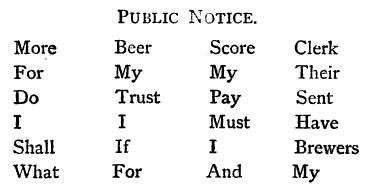If you choose an answer to this question at random, what’s the chance that you’ll be correct?
(a) 25% (b) 50% (c) 0% (d) 25%
If you choose an answer to this question at random, what’s the chance that you’ll be correct?
(a) 25% (b) 50% (c) 0% (d) 25%
A 1936 poser by British puzzle maven Hubert Phillips:
A man I met in Fleet Street yesterday told me the following anecdote:
‘I met yesterday (he said) a friend of mine whom I had not seen since I was at Oxford. That was some years ago and we had not, during all that time, had any communication with one another. Nor had we at Oxford any friends or acquaintances in common.
‘I was delighted to see my friend, nevertheless. “I suppose,” I said, “that lots of things have happened to you.”
‘”Why, yes,” was the answer. “I am married now and this is my little girl.”
‘I looked at the child — a pretty little thing of about six. “And what is your name, my dear,” I asked her. “Margaret,” was the reply. “Aha,” said I, “the same name as your mother’s.”‘
How did the speaker know?

Bishop Samuel Wilberforce was fond of riddles. After his death in 1873, this one was found among his literary papers:
I’m the sweetest of sounds in Orchestra heard,
Yet in Orchestra never was seen.
I’m a bird of gay plumage, yet less like a bird,
Nothing ever in Nature was seen.
Touch the earth I expire, in water I die,
In air I lose breath, yet can swim and can fly;
Darkness destroys me, and light is my death,
And I only keep going by holding my breath.
If my name can’t be guessed by a boy or a man,
By a woman or girl it certainly can.
No one knows the answer.
07/05/2013 UPDATE: A great many readers have sent me proposed answers since I posted this item. The overwhelming favorite is “a whale” (or “orca”); others include “a woman’s voice” and “a soap bubble.” The latter was favored by Henry Dudeney (in his 300 Best Word Puzzles) — he, like everyone, is confident of his solution:
“We have no doubt that the correct answer is that we gave (apparently for the first time in print) in the Guardian for 6th February, 1920. This answer is the word BUBBLE. It is an old name for Bagpipes, the word exactly answers every line of the enigma, though the final couplet may be perplexing. The explanation is that ‘Bubble’ is an old name for breast.”
A pilot is about to depart in his plane when he meets a young woman on the airport concourse. She has missed her flight.
“I can give you a lift if you like,” he says.
“But you don’t know where I’m going,” she says.
“It doesn’t matter. I can drop you off wherever you like and continue to my destination without going out of my way.”
This seems preposterous until he explains where he’s going. Where is it?

William West noticed this inscription in an alehouse near Brighton. What does it mean?